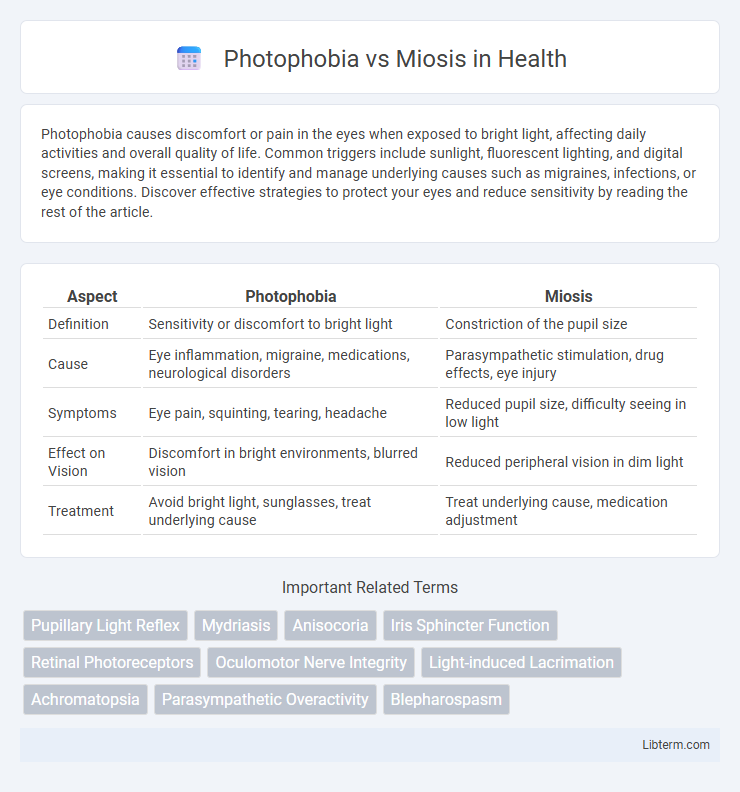Photophobia causes discomfort or pain in the eyes when exposed to bright light, affecting daily activities and overall quality of life. Common triggers include sunlight, fluorescent lighting, and digital screens, making it essential to identify and manage underlying causes such as migraines, infections, or eye conditions. Discover effective strategies to protect your eyes and reduce sensitivity by reading the rest of the article.
Table of Comparison
| Aspect | Photophobia | Miosis |
|---|---|---|
| Definition | Sensitivity or discomfort to bright light | Constriction of the pupil size |
| Cause | Eye inflammation, migraine, medications, neurological disorders | Parasympathetic stimulation, drug effects, eye injury |
| Symptoms | Eye pain, squinting, tearing, headache | Reduced pupil size, difficulty seeing in low light |
| Effect on Vision | Discomfort in bright environments, blurred vision | Reduced peripheral vision in dim light |
| Treatment | Avoid bright light, sunglasses, treat underlying cause | Treat underlying cause, medication adjustment |
Understanding Photophobia: Definition and Causes
Photophobia is an abnormal sensitivity to light causing discomfort or pain in the eyes, often linked to conditions such as migraines, corneal injuries, or meningitis. It differs from miosis, which is the constriction of the pupil typically caused by bright light or certain medications. Understanding photophobia involves recognizing its triggers, including eye inflammation, neurological disorders, or exposure to intense lighting, which helps in accurate diagnosis and treatment.
What Is Miosis? Key Facts Explained
Miosis is the medical term for excessive constriction of the pupil, often caused by exposure to bright light, certain medications, or neurological conditions. This pupil constriction reduces the amount of light entering the eye, contrasting photophobia, which is sensitivity to light causing discomfort. Understanding miosis involves recognizing its role in protecting the retina and its association with disorders such as Horner's syndrome and opioid intoxication.
Distinguishing Photophobia from Miosis
Photophobia is characterized by an abnormal sensitivity to light causing discomfort or pain in the eyes, whereas miosis refers to the constriction of the pupil, typically as a physiological response or due to certain medications and neurological conditions. Distinguishing photophobia from miosis involves assessing whether the symptom is related to light sensitivity (photophobia) or pupil size changes (miosis), as photophobia affects the subjective experience of light, while miosis is an objective physical sign observed during eye examination. Accurate diagnosis requires comprehensive clinical evaluation, including pupillary light reflex testing and patient symptom reports, to determine the underlying cause and guide appropriate treatment.
Common Symptoms of Photophobia
Photophobia is characterized by an abnormal sensitivity to light, causing discomfort or pain in the eyes when exposed to bright environments, often accompanied by squinting, watery eyes, and headaches. Miosis, the excessive constriction of the pupils, typically results from neurological conditions or drug effects without causing light sensitivity or eye pain. Common symptoms of photophobia include eye redness, tearing, and difficulty keeping the eyes open in well-lit spaces, which are not features of miosis.
Identifying Signs of Miosis
Miosis is characterized by excessive constriction of the pupil, resulting in an abnormally small pupil size even in low light conditions, which contrasts with the dilated pupil often seen in photophobia. Key signs of miosis include pinpoint pupils unresponsive or sluggish to light stimuli and reduced pupillary reflex, which can be detected during a neurological examination. Identifying these signs is crucial for diagnosing underlying causes such as opioid use, Horner's syndrome, or exposure to certain toxins.
Underlying Medical Conditions Linked to Photophobia
Photophobia often signals underlying medical conditions such as migraines, meningitis, or uveitis that heighten sensitivity to light, unlike miosis, which is primarily related to neurological or pharmacological causes affecting pupil constriction. Conditions like traumatic brain injury and meningitis frequently present photophobia as a symptom due to inflammation or increased intracranial pressure. Identifying photophobia can aid in diagnosing these serious illnesses, whereas miosis is more commonly associated with opioid use, Horner's syndrome, or exposure to certain toxins.
Health Disorders Associated with Miosis
Miosis, characterized by the excessive constriction of the pupil, is often linked to health disorders such as Horner's syndrome, opioid overdose, and certain neurological conditions affecting the autonomic nervous system. Unlike photophobia, which involves light sensitivity causing discomfort or pain, miosis results from abnormal parasympathetic activation leading to reduced pupil size. Identifying miosis is critical in diagnosing underlying issues like brainstem lesions or exposure to cholinergic drugs, which require medical intervention.
Diagnostic Approaches for Photophobia vs Miosis
Diagnostic approaches for photophobia involve clinical assessment of light sensitivity through patient history and specialized tests such as slit-lamp examination to detect ocular surface abnormalities or inflammation. In contrast, miosis diagnosis emphasizes pupillary light reflex evaluation, including penlight examination and pharmacologic testing to distinguish causes like Horner's syndrome or drug-induced constriction. Advanced imaging and neurological assessments may be employed to identify underlying pathologies contributing to either photophobia or miosis.
Treatment Options for Photophobia and Miosis
Treatment options for photophobia primarily involve managing the underlying cause, such as using tinted lenses or sunglasses to reduce light sensitivity and prescribing medications for associated conditions like migraines or eye inflammation. Miosis treatment depends on identifying the root cause, with options including anticholinergic eye drops (e.g., tropicamide) to dilate the pupil or addressing systemic causes such as opioid toxicity or neurological disorders. Both conditions require tailored medical approaches focused on symptom relief and addressing underlying pathologies to restore normal pupillary function and comfort.
Preventive Strategies and Lifestyle Tips
To prevent photophobia, wearing polarized sunglasses, using blue light filters on screens, and maintaining proper lighting indoors reduce eye strain and light sensitivity. For miosis, avoiding prolonged exposure to bright lights and managing underlying conditions like uveitis or medication side effects help control excessive pupil constriction. Regular eye exams and hydration support overall eye health and can mitigate symptoms related to both photophobia and miosis.
Photophobia Infographic

 libterm.com
libterm.com